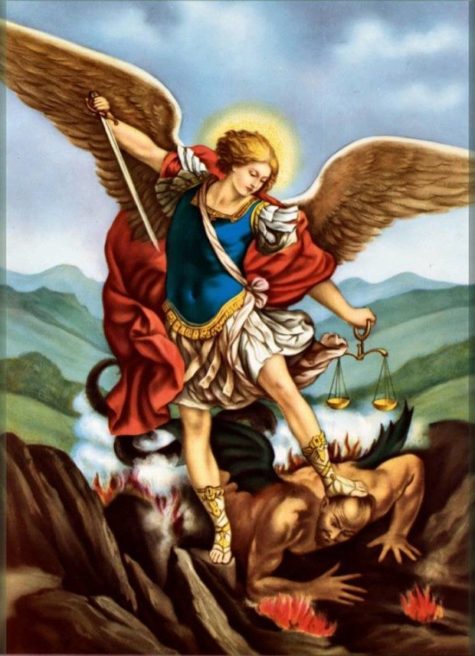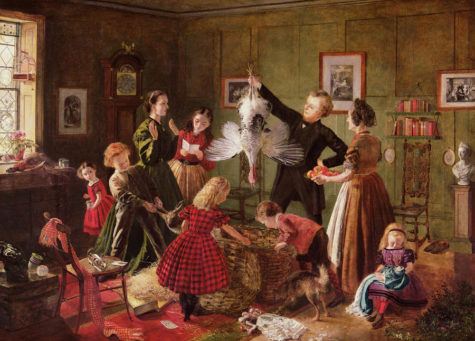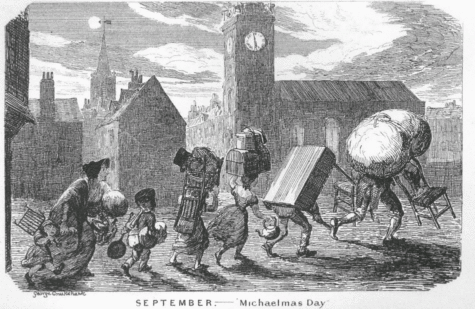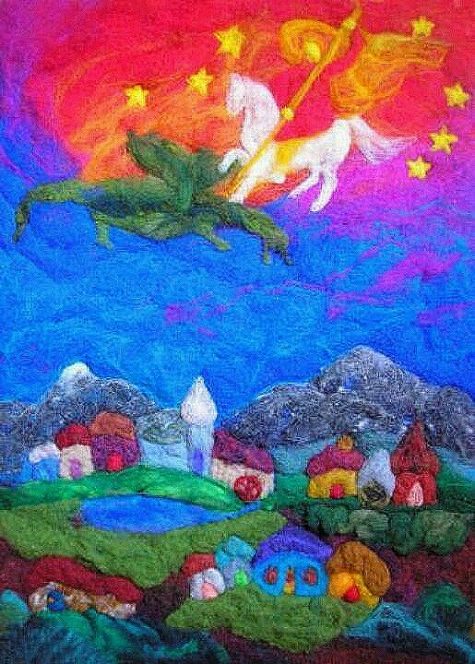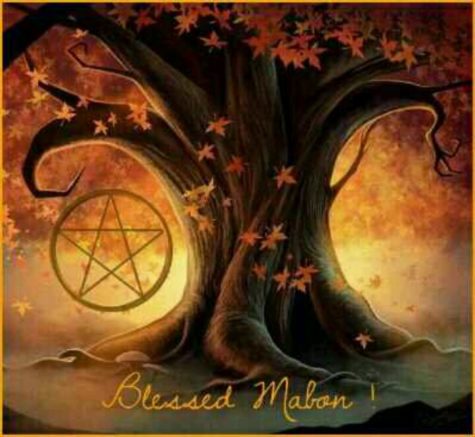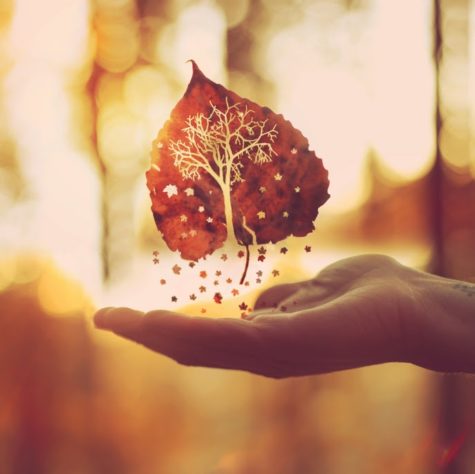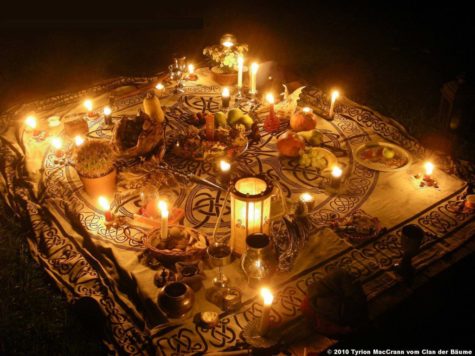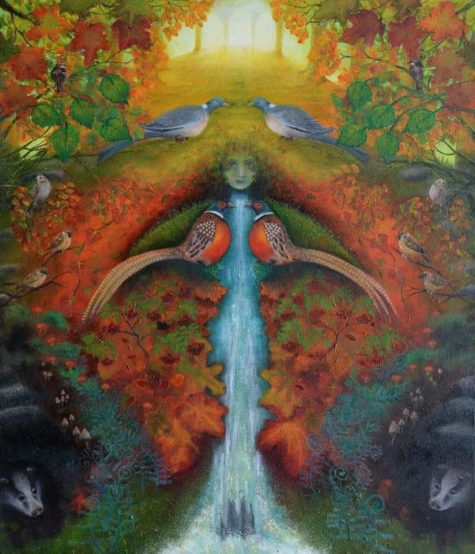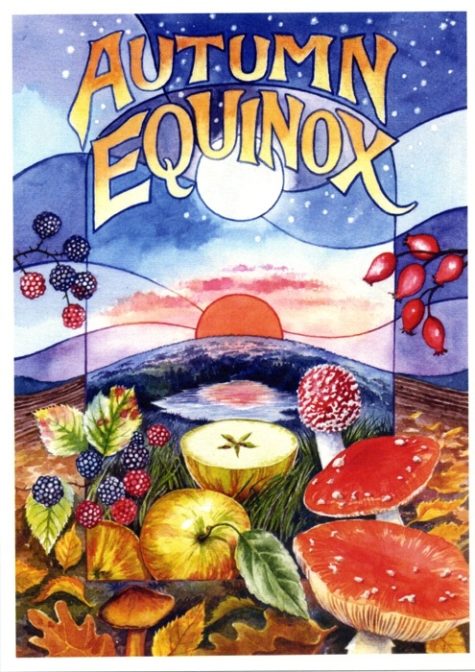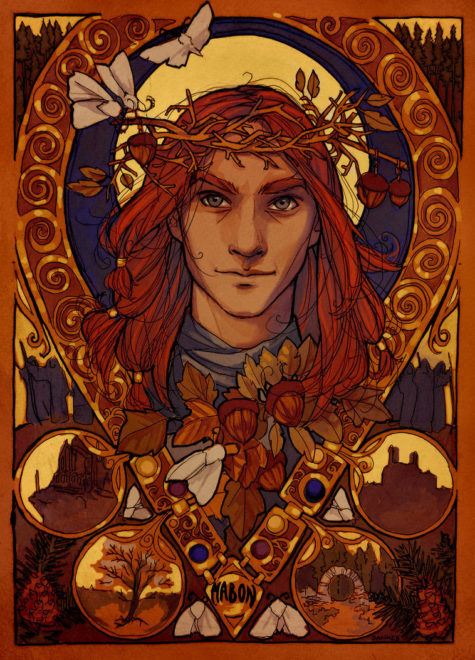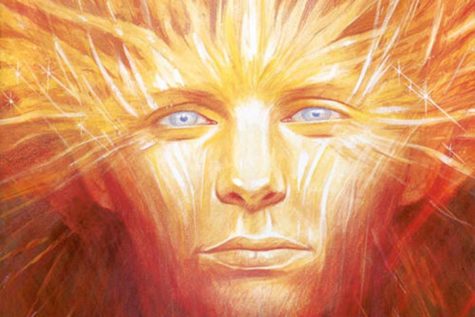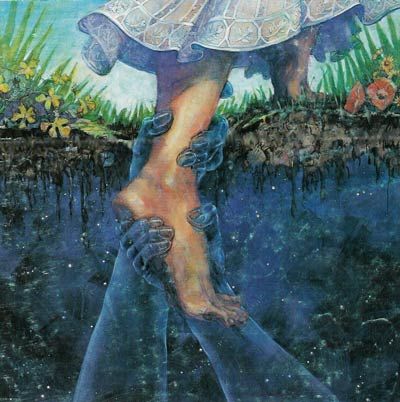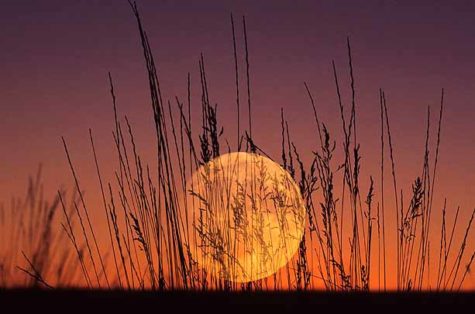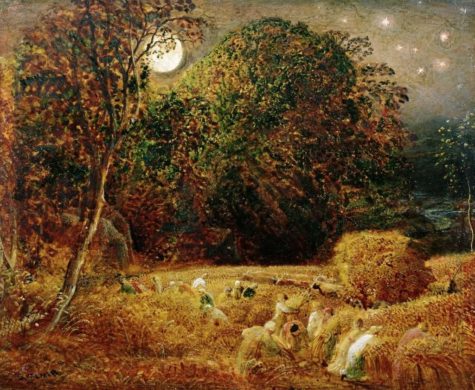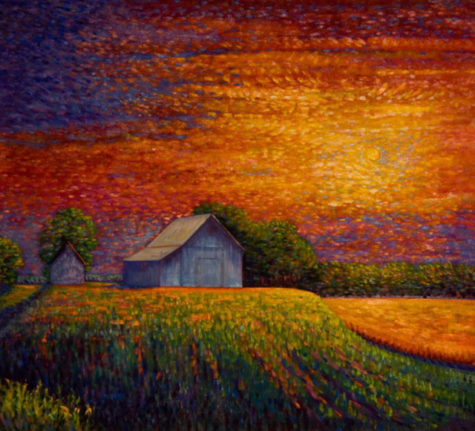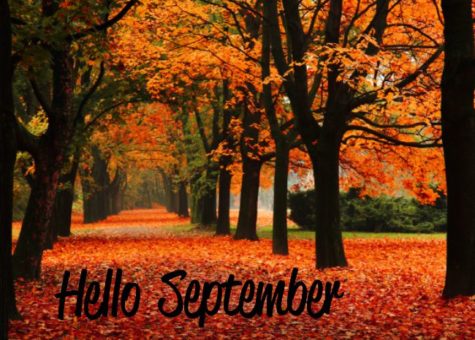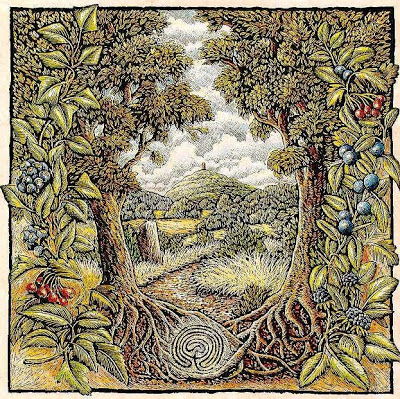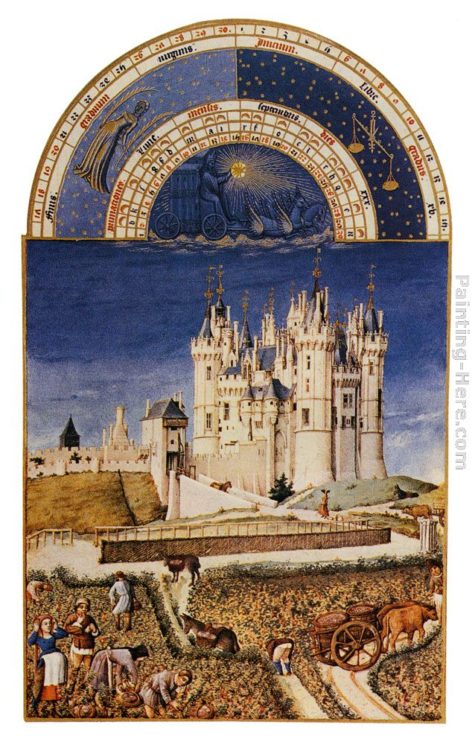September Lore
September 29th is a medieval holiday which the Church Christianized under the label of “Michaelmas,” a feast in honor of the Archangel Michael. It is thought that the Roman Catholic Church at some point considered assigning the quarter dates to the four Archangels, since they had assigned the cross quarters to the four gospel-writers.
The feast day of St. Michael, the archangel and overcomer of the Devil, is a Christian celebration. Its main importance in people’s lives was that of a seasonal signpost in the year. In the British Isles, crops were harvested and the surplus sold by late September, so this became the time when farmers would pay their yearly rents to landowners.
Everyone ate goose at Michaelmas to bring prosperity, and many farmers included “a goose fit for the lord’s dinner” with their rent payments. Great market fairs occurred just before the feast day, and the large crowds these attracted made it convenient to hold elections at this time. Michaelmas is also a “Quarter Day.”
The ancient Celtic people divided the year into four major sections, or quarters, and then divided each of these in half to make an eight-part year that reflected the natural progression of the seasons. Foods traditional for Michaelmas include new wine; goose; cakes of oats, barley, and rye; and carrots. Some groups in the United States, such as the Pennsylvania Dutch, have kept Michaelmas, or “Harvest Home,” traditions alive.
During the Middle Ages, Michaelmas was celebrated as a Holy Day of Obligation, but this tradition was abolished in the 18th century. Lutheran Christians consider it a principal feast of Christ.
It was also one of the Welsh and Irish quarter days when accounts had to be settled. On manors, it was the day when a reeve was elected from the peasants. Traditional meal for the day includes goose (a “stubble-goose”, i.e. one prepared around harvest time) and a special cake called a St Michael’s bannock.
A Note About Dates:
There is evidence that Michaelmas was once celebrated later in the year, on the 10th or 11th of October, this is now referred to as ‘Old Michaelmas Day’. There may also have been a time when both dates for Michaelmas were acknowledged.
I like the legend of teenage girls collecting crab apples at the beginning of September, and arranging them in the initials of boys they fancied. If they could still discern the initials on Old Michaelmas Day, then then true love and romance would follow. The legend conjures two unrelated thoughts in my mind, firstly, would other girls mischievously re-arrange the apples to form the initials of a different boy. Secondly, what is the modern equivalent of this courtship ritual?
It’s interesting that certain customs transfer from one season to another. For example, two people snapping the the Michaelmas goose’s wishbone and thinking of a secret desire. Also, the concept of a Michaelmas Pie with ring, according to this legend, the lucky recipient will be engaged by Christmas and marry by Easter. Variations on these themes occur at Christmas and possibly at Thanksgiving.
Michaelmas Customs and Lore
According to an old legend, blackberries should not be picked after this date.
This is because, so folklore goes, Satan was banished from Heaven on this day, fell into a blackberry bush and cursed the brambles as he fell into them. In Yorkshire, it is said that the devil had spat on them. This old legend is well known in all parts of the United Kingdom, even as far north as the Orkney Islands. In Cornwall, a similar legend prevails, however, the saying goes that the devil urinated on them.
This is one Michaelmas custom that survives to this day, although sometimes it is said that you should not eat blackberries after the 29th of September. There is a very good reason for this custom, namely that by this time of year blackberries are tasteless and watery.
Other fruits, particularly nuts and rose-hips also have customs associated with Michaelmas. For example, ‘Hipping Day’ in Yorkshire, or Michaelmas pie in Ireland (Made of apples).
- Mop Fairs (Hiring Time):
Michaelmas was traditionally time when laborers and servants were hired. As the name suggests, maids would carry mops, but other trades carried the tools of their trades.
Thus the squires or the lord’s of the manor could tell what skills the prospective employees had, for example, a Shepherds his crook, and a gardener a rake.
- Fishing:
Michaelmas marks the end of the fishing season.
- Curfew:
The start of the curfew for winter night nights. The local church bell sounded each night from Michaelmas until lent. Curfew is derived from the French phrase ‘courve feu’, which means to cover, or to dowse a fire.
- Rent:
When tenants came to pay their quarter’s rent, they bring a fowl at Midsummer, a dish of fish in Lent, a capon at Christmas, and on Michaelmas Day, a goose.
- Trees:
This is traditionally a good time to plant trees as evidenced by this old saying, “A Tree planted at Michaelmas, will surely not go amiss.”
More Michaelmas Lore:
At Michaelmas time, or a little before,
Half an apple goes to the core;
At Christmas time, or a little after,
A crab in the hedge, and thanks to the rafter.
- If you eat goose on Michaelmas Day, you will not be short of money all year round.
- A Michaelmas rot comes ne’er in the pot.
- If St Michael brings many acorns, Christmas will cover the fields with snow.
- Michaelmas chickens and parsons’ daughters never come to good.
- Three things that never come to any good: Christmas pigs, Michaelmas fowls, and parsons’ daughters.
- So many days the moon is old on St Michael’s day, so many floods after.
- Harvest comes as long before Michaelmas as dog roses bloom before Midsummer.
- On Michaelmas Day the devil puts his foot on the blackberries.
- St Michael’s rain does not stay long in the sky.
- If it does not rain on St Michael’s and Gallus [Oct 16], a dry spring is indicated for the next year.
Collected from a variety of sources
Mabon (pronounced MAY-bun, MAY-bone, MAH-boon, or MAH-bawn) marks the Second Harvest, the end of the grain harvest (which begun at Lughnasadh), and rests on the Autumn Equinox. The Equinox mirrors dwindling of life (and eventual progression to rebirth), as well as the struggle for balance; day and night are equal for a single day.
- Celebrated with wine, apples, garlands, gourds and cornucopias.
- With decorations of orange, russet and maroon.
- Honoring the aging Gods and Harvest deities.
Various other names for this Lesser Wiccan Sabbat are The Second Harvest Festival, Wine Harvest, Feast of Avalon, Equinozio di Autunno (Strega), Alben Elfed (Caledonii), or Cornucopia.
Mabon is a celebration of life and death, and giving of life again, the cycle of the seasons. Mabon is a time to enjoy the fruits of a hard year’s labor, to stock up for the long winter. No matter how you celebrate Mabon, or how it came about, or whatever it’s true name may be, it is important to know that Mabon a time for giving thanks.
At the Autumn Equinox we all take a moment to pay our respects to the impending dark. We also give thanks to the waning sunlight, as we store our harvest of this year’s crops.
During this festival it is appropriate to wear all of your finery and dine and celebrate in a lavish setting. It is the drawing to and of family as we prepare for the winding down of the year at Samhain. It is a time to finish old business as we ready for a period of rest, relaxation, and reflection.
The pagans of antiquity didn’t have the ability to determine astrological positions as we do today. The European peasantry, therefore, celebrated this Sabbat on September 25th; actually, the Celts marked their days from sundown to sundown, so the Mabon celebration actually started on the sundown of our September 24th. Today, with the help of our technology, we can calculate the exact day of the Equinox; the date when the sun enters the sign of Libra, the Balanced Scales, which appropriately fits the Equinox.
The Druids call this celebration, Mea’n Fo’mhair, and honor the The Green Man, the God of the Forest, by offering libations to trees. Offerings of ciders, wines, herbs and fertilizer are appropriate at this time. Wiccans celebrate the aging Goddess as she passes from Mother to Crone, and her consort the God as he prepares for death and re-birth.
The Teutonic name, Winter Finding, spans a period of time from the Sabbat to Oct. 15th, Winter’s Night, which is the Norse New Year.
As a holiday, Mabon represents the time of honoring the dead, visiting burial sites, giving thankfulness for the end of the harvest season and the bounty it provides. These are the themes of closing, letting go and remembering. For the year, the harvest and for those who were lost to land of Avalon during the year.
Decorations and Activities for Mabon
Activities vary with region and tradition, as well as personal preference. Some ideas include making a Sun Wheel or wreath. Also, one could mirror the Celtic tradition of dressing a corn stalk in cloths and burning it in celebration of the harvest and upcoming rebirth.
Simple altar decorations can be obtained by taking a calm “pilgrimage” through your local woods and collecting leaves, acorns, berries, and other things symbolic of nature’s bounty. Some chose to sprinkle Autumn leaves around the house and on the sides of walk ways as decoration, though this may not be convenient if one lives in the city or doesn’t enjoy the cleanup. Alternately, the changing leaves can be dipped in paraffin and put on wax paper. After the leaves dry, they may be placed around the house or in large jars with sigils of protection and/or abundance carved lightly into them.
Additional seeds and grains can be set out as offering to our fellow creatures, and provide a healthy chance for birds to join in the celebrations as well. Symbolic designs can be made out of the sprinklings if one chooses. Those less fortunate should not be omitted from the celebration. Small, meaningless (to you) packages of food and drink gifted to a homeless person will make their day!
To honor the dead, it is traditional to place apples on burial cairns as symbolism of rebirth and gratitude. This represents the promise of the Great Spirits for renewed life (a new incarnation). Furthermore, it is a time to honor the elders, who have devoted so much time and energy to your growth and development. Something special is in order for these gracious people.
Going through your personal gardens with thanks and lovingly harvesting what is ready is also appropriate. Breads may be baked in the shape of the Sun, combining fruits or vegetables and grains, incorporating both of the major aspects of this Harvest. The seeds of various plants are stored through winter for replanting, and therefore, the plant’s rebirth in the Spring. A feast for friends and family always provides a cheerful abundance of energy and thanks.
Although many view the Harvest season as a celebration of life, it is also a celebration of death. The bounty you gather from your garden provides nourishment for you, family and friends. But it is also the death of those plants and vegetables which have been harvested from that garden. Thus Mabon is a celebration of the cycle of life.
This is a Celtic festival of thanksgiving, so what a better way to give thanks than to prepare a meal with the harvest of your garden. Those that indulge in wine can brew a new batch of this home made nectar of the Gods. Those that do not indulge, can brew preserves and jellies from grapes, raspberries and blackberries. Don’t forget an apple pie for dessert.
A main course can consist of meats, most often red meats. But this is just a suggestion. In this day and age of healthy eating, you should prepare a meal that fits your personal lifestyle. However, your side dishes should consist of late summer and early fall vegetables.
During your meal, share tales and happy stories about those you lost during the year. Or share your experiences and review the lessons you feel you have learned during this past season. Reflect on your deeds and actions and give thanks for the gifts you were given.
After your meal, share the chore of cleaning up. This is a way of showing honor and respect to your host and hostess. Think of it as a physical action to show that you understand the interconnection of all life and the desire to respect what you have been given and thanks for receiving those gifts.
During the evening hours you can continue the festival with a formal holiday ritual. There are as many ways and suggestions for conducting such a ceremony as there are people on this planet.
End your evening in private reflection. It is important for anyone practicing a spiritual life to reflect on his or her actions. Record your thoughts, your emotions and your experiences. This is the true value of your book of shadows. And there is no better time to take stock of yourself and your life than during a High Holy Day.
Ritual For Mabon
This Ritual is best performed during the early evening hours, just after Sunset, as this is the time of day which corresponds to the time of year. Sweep area, starting in the North and moving deosil (clockwise or sunwise direction), with your magickal broom to cleanse the Circle area and “sweep away” any lingering negative energies. Lay out the circumference of your Circle with cord, stones, etc., as necessary.
Set up the Quarter candles (North-Green, East-Yellow, South-Red, West-Blue) and/or other items symbolizing the elements at the Four Quarters (use a compass if not permanently marked out). Set up your altar as desired, and face it to the North, covering it with the red altar cloth.
Place all of the items listed below in their proper places upon it. For this ceremony, decorate the altar with the cornucopia filled with harvest items, and whatever else feels right. In addition to your usual tools and props, upon the altar should be:
- Red or Brown Altar Cloth
- Cornucopia filled with Fruits and Vegetables of the Harvest
- A Red Apple
- Bolline or another Sharp Knife (for cutting the Apple)
- Altar Pentacle or a Plate (to cut the apple on)
- A Bell
- A Second Wand decorated with Colored Ribbons (to use in the Demeter/Persephone portion of the ritual)
- A Wicker Basket (to carry the Decorated Wand in)
- Incense – Any of the following either alone or mixed together to make an Autumn Blend: Frankincense, Aloes Wood, Jasmine, Cinnamon, Musk, Cloves, Benzoin, Myrrh, and Sage
When all is set up, take a shower or bath for purification and don your ritual robe or other ritual attire. Be sure to wear your magickal jewelry. Sit quietly and meditate for a little while – to ground and center before beginning the Ritual. When you feel ready to begin, play some quiet peaceful music for the ritual.
Cast a circle in whatever way is familiar to you. After the Circle is cast, begin the Mabon sabbath Ceremony by sitting quietly for a few moments, then say these words aloud in dedication:
“Lady Autumn, Queen of the Harvest,
I have seen You in the setting Sun,
with Your long auburn tresses
blowing in the cool air that surrounds You.
Your crown of golden leaves is jeweled
with amber, amethyst, and rubies.
Your long, flowing purple robe
stretches across the horizon.
In Your hands You hold the ripened fruits.
At Your feet the squirrels gather acorns.
Black crows perch on Your outstretched arms.
All around You the leaves are falling.
You sit upon Your throne and watch the dying fires
of the setting Sun shine forth its final colors in the sky.
The purple and orange lingers and glows
like burning embers.
Then all colors fade into the twilight.
Lady Autumn, You are here at last.
I thank You for Your rewards.
I have worked hard for these gifts.
Lady Autumn, now grant me peace and rest.”
Sit quietly again and reflect on the meaning of the Autumn Season for a little while.
When you are ready, pick up your wand and hold it in your power hand, face the North and with your arms outstretched (kneel or stand) and say:
“The Wheel of the Year turns on and on,
bringing us all to and from each Season,
and from and to another.
What will be is. What was will be.
All time is here and now in this Sacred Space.
I now pause to watch the Wheel turn
and cast this Circle on this blessed eve
to celebrate the Season of Mabon, the Autumnal Equinox –
the time of the Second Harvest.
In this moment between time,
I come to praise the bountiful aging Goddess
and Her consort, the God of the Harvest.
I wish to give thanks and feel myself
as a part of the relentlessly turning
wheel of life, death, and rebirth.
O Great God of Wine and the Harvest,
who has been known as Mabon, Dionysus, Bacchus, and Thor –
Grant me strength and understanding
throughout this season and always.
O Great Goddess of the Harvest and the Underworld,
who has been known as Demeter, Persephone, Modron, and Morgan –
Teach me the secrets of the Mysteries and the ways of magic.”
Place your wand back in its place on the altar.
Spread your hands out over the Harvest Altar and say these words:
“The time of change is upon us again –
the Equinox comes, the Wheel turns…
The Goddess and the God prepare for
Their journey to the Otherworld,
as the Earth and all of Her children
prepare for the time of quiet and
reflection that lies ahead…
May I use this Autumnal period to
seek for the strength and power within
to assist me on my own quest for
vision, feeling, and peace…
May I see and feel the presence of
the Goddess and the God within,
though without,
the Earth begins Her slumber…
Keep me in Your light…”
Lower your arms and sit quietly meditating again for a while.
When you are ready, stand at your altar facing the North and raise your arms in greeting. Say:
“Between the worlds I build this sacred altar.
Outside of time, this rite leads to the ancient way.
Where I may find Demeter of high Olympus
And conjure magic great. Be here, I say.”
Place the decorated wand in the wicker basket and carry it to the North. Say:
“Persephone returns to the Underworld.
Weep not, Earth Mother,
For the Divine Child of love is here.”
Carry the basket to the East; say:
“Persephone returns to the Underworld.
Although the Light is fading,
It shall return to the Earth.”
Take the basket to the South; say:
“Persephone returns to the Underworld.
The cold of winter comes,
But only for a short time.”
Finish by carrying the basket to the West; say:
“Persephone returns to the Underworld.
The Earth shall lie in slumber
Until the Light of this Divine Child
Once more grows in strength and shines full upon us.”
Place the basket on the floor before the altar. Ring the bell three times.
Take your bolline in your power hand and the apple in the other. Say:
“Reveal to me your hidden secrets
That I may come to understand your sacred Mysteries.”
Set the apple on the altar pentacle (or plate) and cut it crosswise (with the bolline) to reveal the pentagram in the core. Contemplate this hidden sacred symbol for several moments. Then say:
“In life is death, in death life.
All must follow the sacred dance into the cauldron,
Time after time, to die and be reborn.
Help me to remember that
Every beginning has an ending
And that every ending has a new beginning.”
Take a bite of the apple.
What is left put outside later to share with the birds.
Say:
“Holy Mother, Demeter,
Comfort and protect me in my times of tribulation.
Instruct me into the Mysteries.
You, with your daughter Persephone, have the power
To lead me to new understanding.”
Now is the time for meditation and any spellworkings you may need or desire to end your sabbath celebration. Appropriate Spellwork for Mabon include those for protection, wealth and prosperity, security and spells to bring a feeling of self-confidence. If no spellwork is to be done at this time, then proceed with the Cakes and Ale Ceremony – or whatever is your practice, followed by Releasing the Magic Circle.
Please note this ritual is based on the Northern Hemisphere correspondences of elements and their colors, and directions and so on.
Mabon History
Mabon (May-bawn) is also known as the Feast of Avalon and the festival of the Wine Harvest. To the Celts, Avalon is the mysterious place for the land of the dead. and literally means the “land of apples”. Thus this is a holiday for celebrating the bounty of the harvest and the desire for the living to be reunited with their deceased loved ones.
But the holiday is also named for the Welsh God Mabon. Mabon means the “great son”. He was the son of Modred, kidnapped at the age of 3 and later rescued by King Arthur. His life represents the innocence of youth, the strength of survival and the growing wisdom of the elderly. Perhaps it is this view of the cycle of life that brings Mabon to his most popular role, the King of the Otherworld and the God of Darkness.
His myths overlap with other Gods such as the Welsh God Gwyn Ap Nuad, which means “white son of darkness”. He is seen as the God of war and death, the patron God of fallen warriors. Once again this is a representation or connection to the Land of Avalon.
Sources:
Autumn Equinox refers to a time of the year when day and night are equally balanced. The dates vary slightly, falling between Sept 21 and Sept 23. The sun is in the process of crossing the equator and in astrological terms is entering the sign of Libra.
The sun is the focal point of energy (along with the moon) and such; its life force pushes us to discover more about ourselves. This movement into the Libra puts a congenial, cooperative outlook on that time of year, just what was needed by the communities, as they all worked together to complete the harvest.
Other names for the Autumnal Equinox include:
- Alban Elfed
- Cornucopia
- Equinozio di Autunno
- Fall Equinox
- Feast of Avalon
- Festival of Dionysus
- Festival of Strong Will
- Harvest Home
- Second Harvest Festival
- Wine Harvest
- Winter Finding
Harvest Home is an Anglo-Celtic version of the original Mabon, and fell in-between the First (Lugnasadh) and the Third (Samhain) Harvests. Harvests festivals were a very important part of the pre- industrialized culture. It was a time of relief and of rest. Relief that the crops were in and rest to catch their breath before the work of preparing for winter began. This was a time to give thanks.
- Color of the day: Yellow
- Incense of the day: Coriander
Once again the Sun’s path crosses the celestial equator, and the day and the night are now again of equal length. On the Gregorian calendar this is the first day of autumn, but on the modern Celtic calendar it is midautumn.
Autumn Equinox in Welsh Mythology
This holiday is more commonly known by its Welsh name Mabon. Mabon means “divine youth.” It is the name of a mythic hunter hero whose story is told at this time of year. At the beginning of time, Mabon was born to the mother goddess Modron. That we only know his mother and not his father attests to the matriarchal lineage of the early Celts.
The equinox marks the time when Mabon was three nights old and stolen from his crib. For the next three months, the heroes Cai and Bedwyr will search for him and ask all manner of birds and beasts for help. But, according to legend, it is only the salmon who can give them direction. On Yule, the heroes retrieve the divine child by freeing him from a prison in Gloucester.
Like Apollo, Mabon is a hunter with a bow and a musician with a harp. He is a Sun god. Mabon represents the Sun that is waning in strength during this quarter of the year and that will begin to return only after the solstice. The waning of the light is frightening and depressing, and it is necessary for our own sake to use magic at this time to help in the quest for Mabon.
The strongest act of magic that one can do at this time is to participate in the celebrations of the yearly cycle. As one integrates the yearly cycle deep into one’s unconscious, serenity and confidence are gained. This is the peace that comes from knowing and accepting that the light will return when it is time.
Autumn Equinox in Celtic Mythology
In this variation of the legend of the Autumn Equinox, this is the day of the year when the god of light, Lugh, is defeated by the god of darkness, Lugh’s twin and alter-ego, Tanist. The night conquers day.
The tales state that the Equinox is the only day which Lugh is vulnerable and the possibility of his defeat exists. Lugh stands on the balance (Autumn Equinox-Libra) with one foot on the goat (Winter Solstice-Capricorn) and the other on the cauldron (Summer Solstice-Cancer). He is betrayed by Blodeuwedd, the Virgin (Virgo) and transformed into an Eagle (Scorpio).
Two events occur rapidly with Lugh’s defeat. Tanist, having beaten Lugh, now takes over Lugh’s place both as King of our world and lover to the Goddess Tailltiu. Although Tanist now sits on Lugh’s throne, his official induction does not take place for another six weeks at Samhain, the beginning of Winter, when he becomes the Dark King, the Winter Lord, the Lord of Misrule. He mates with Tailltiu, who conceives, and will give birth nine months later (at the Summer Solstice) to her son, another incarnation of Tanist himself, the Dark Child.
Lugh’s sacrifice represents not only the sun’s dying power, but also the cycle of rebirth, his energy remaining within the corn we have since harvested. A incarnate (of Lugh) corn spirit was thought to specifically reside within the last stalk (or stock), which was traditionally dressed in fine clothes and decorations, or woven into a wicker man-shaped form. This symbolic decoration was then harvested and carried from the field to be burned with rejoicing for the spirits release and Lugh’s upcoming rebirth.
The Autumn Equinox in Greek Mythology
In Greek mythology, Autumn begins as Persephone returns to the Underworld to live with Hades, her husband.
In short, the myth says that Demeter’s daughter, Kore, had taken a day to pick flowers in a meadow when the Earth opened up, and Hades pulled the girl into the Underworld to become his bride. Kore’s name became Persephone when she married Hades.
For nine straight days, Demeter searched for Kore, with no success. In misery and despiration, Demeter questioned Helios, the Sun God, who informed her that her brother, Zeus, had given the girl to Hades. Furious, Demeter left Olympus to roam the Earth disguised as an old woman, ending up settled in her temple at Eleusis.
Soon after, she cursed the Earth so it would yield no crops. Zues sent her a frantic message inquiring as to why she had prevented growth on the planet. She replied that there would be no regeneration of vegetation on the Earth until her daughter, Kore, was safely returned.
Zeus immediately dispatched Hermes into the Underworld to retrieve the girl. Hades, not wanting to relinquish his bride permanently, convinced Persephone to eat some pomegranate seeds before she returned to her mother, Demeter. Demeter was yet again distraught when she learned of this trickery! Finally, Zeus declared that Kore-Persephone would live with her mother during one half of the year and return to her husband, Hades, during the other half. In thanks, Demeter lifted the curse on the Earth, creating Spring. Every year hence, during her time of greatest sorrow, Demeter renews the curse, as her daughter returns to Hades and the Underworld.
Sources:
- Ravenna’s Wheel of the Year
- Widdershins
- Gordon Ireland
- Llewellyn’s Spell A Day
The Full Moon in September is all about emotions, healing, and balancing. This is a time of organizing and preparing for the coming months.
“This powerful Gateway is an opportunity to greatly accelerate your spiritual growth and to promote Balance in your life. Divine Masculine supports the Divine Feminine. As they come together in Sacred Marriage, you realize that one without the other is not balanced. So, do not act unless it is aligned with your Integrity; your Heart. Be inspired and then take a step toward your dream.”
– Ascension: Soulstice Rising
The Farmer’s Almanac tells us that this full moon’s name is the Full Corn Moon, attributed to Native Americans because it marked when corn was supposed to be harvested, however some calendars attribute the Corn Moon to the month of August. Most often, the September full moon is actually the Harvest Moon, which is the full Moon that occurs closest to the autumn equinox.
In two years out of three, the Harvest Moon comes in September, but in some years it occurs in October. At the peak of harvest, farmers can work late into the night by the light of this Moon. Usually the full moon rises an average of 50 minutes later each night, but for the few nights around the Harvest Moon, the Moon seems to rise at nearly the same time each night: just 25 to 30 minutes later across the U.S., and only 10 to 20 minutes later for much of Canada and Europe.
Corn, pumpkins, squash, beans, and wild rice, the chief garden and native staples, are now ready for gathering.
The September Moon is also known as Harvest Moon, Barley Moon. The harvesters would gain extra time in the fields by the light of the harvest moon.
Please take a seat and clear your mind of what fills it now and hear my words:
As you are sitting, close your eyes and feel the yellow of the sun..Reach up with your arms and let your fingertips touch that yellow..Now, lay back, with your arms extended and become a ray of the sun..As we all lay in a circle, we form the sun – we are all rays of this vivid starburst.
Look down to the Earth and see the fields ripe with the summer’s abundance..Find your self in the center of this abundance holding a large willow basket, eager to begin your autumn harvest.
Step first into an expanse of sweet corn..See the erect, regal, green stalks of corn..Observe a ripe ear on a particular stalk which extends to you..Under its scruffy whiskers kernels that sparkle like gold shine through. You are reminded of your own riches – both tangible and intangible..Reach out and pick this ear and put it into your basket.
Leave the corn field and enter an orchard; an apple orchard..See the beauty of these trees, these majestic symbols of the Goddess..Feel the fullness of her boughs – full of ruby red apples of knowledge..Reach up, way up, and pick two. Put one in your basket and eat the other. Taste and enjoy this fruit – for in this garden tasting an apple is not forbidden.
Now move toward an onion field which beckons you..Once green, now browning spikes point up to you, tempting you to dig below…Pull gently and the ground gives birth to aniridescent, opal bulb, full of body and character and strength..A vegetable with the power to make you feel the power of tears..Add this to your growing harvest.
Notice ahead thick bushes of ripened raspberries..Sharp brambles protecting their precious, succulent garnets..The sweet nectar of these berries remind you of your own sensuality – your own ability to feel, express, extend all that is soft and loving and warm to others..Take your time here and pick plenty of these supple jewels for your basket.
Step away now and look around you..Find a patch of fruit or vegetables that appeals to you..Enter it, admire its offerings, select a precious gem of your own to harvest..Choose a resource to sustain you in the rapidly upcoming time of cold and darkness…Capture some warmth and light and savor its presence.
With your arms now laden with this basket of bountiful treasures, it is time now to rest..Take your harvest to the grassy knoll in the sun just beyond and sit and bask in the glory of its healing heat..Rest in contentment knowing you have collected that which you need to give you strength and nourishment in the winter days to come.
Put yourself back in the sky now..Become the sun once again..Shine down upon yourself and your gatherings..Absorb the energy of the fruits of your labors, bless these seeds you planted in the Spring and nurtured to fruition through the summer..Be the sun..Shine down upon all that is good and good-giving..Give the light of hope to all you shine upon.
When everything you have touched with your rays is full of your brightness, open your eyes and rejoin our circle.
Sources:
- Journeying To The Goddess
- Magickal Winds
- Meditation by ~Angelica
What follows is a list (in alphabetical order) of the names given to the September moon. Also listed is the tradition and/or origin of that moon name:
Acorns Moon ~Wishram
Autumn Moon ~Passamaquoddy
Barley Moon ~Mediaeval English, Algonquin
Black Butterfly Moon ~Cherokee
Black Calf Moon ~Sioux
Blood Moon ~other
Calves Hair Growth Moon ~Dakota
Corn Moon ~Algonquin, Pueblo
Corn Maker Moon ~Abernaki
Deer Paw Moon ~Omaha
Drying Grass Moon ~Arapaho, Cheyenne, Sioux, Algonquin
Freshness Moon ~Mohawk
Fruit Moon ~Algonquin
Harvest Moon ~Neo-Pagan, Colonial American, Algonquin, Hopi
Hay Cutting Moon ~Yuchi
Leaf Fall Moon ~Kiowa
Little Chestnut Moon ~Creek
Maize Moon ~Natchez
Mulberry Moon ~Choctaw
Nut Moon ~Cherokee
Rice Moon ~Anishnaabe
Ripe Moon ~San Juan
Scarlet Plum Moon ~Sioux
Singing Moon ~Celtic
Snow Goose Moon ~Cree
Soaproot ~Pomo
Sturgeon Moon ~other
Yellow Leaf Moon ~Assiniboine, Taos
Wine Moon ~other
Collected from various sources
September gets its name from the Latin word septum, meaning “seven,” because it was originally the seventh month in the old calendar system. The Anglo-Saxons called it Gerst monath (Barley month), because it was their time to harvest barley to be made into their favorite drink – barley brew. They also called it Haefest monath or Harvest month.
While the early portion of this month has many summery-feeling festivals, slowly we see a change in focus toward the fall and harvest celebrations. Children return to school, outdoor activities start to wane, and the Wheel of Time begins to paint the trees with color.
September’s energy augments magic for prosperity and abundance, balanced with sensibility and a little frugality. It is especially a time for rituals that thank the goddess for all her gifts throughout the year. Beyond this, start making amulets for health so that when the cooler winds come, you’ll be magically fortified.
According to the lore, September is a great month in which to marry:
- Marry in September’s shrine, your living will be rich and fine.
- Married in September’s golden glow, Smooth and serene your life will go.
- A September bride will be discreet, affable, And much liked.
September Correspondences
- Nature Spirits: Trooping faeries
- Herbs: Copal, Fennel, Rye, Wheat, Valerian, Skullcap
- Colors: Brown, Yellow-Green, Yellow
- Flowers: Narcissus, Lily, Aster
- Scents: Storax, Mastic, Gardenia, Bergamot
- Gem: Sapphire
- Stones: Peridot, Olivine, Chrysolite, Citrine
- Trees: Hazel, Larch, Bay
- Animals: Snake, Jackal
- Birds: Ibis, Sparrow
- Deities: Demeter, Ceres, Isis, Nephthys, Freyja, Ch’ang-O, Thoth
- Full Moon: Harvest Moon
- Autumn Equinox: Nature comes into balance
Power flow:
Rest after labor; Balance of Light and Dark. Organize. Clean and straighten up physical, mental, emotional, and spiritual clutter.
September Weather Lore
- Fair on September 1st, fair for the month.
- Heavy September rains bring drought.
- If on September 19th there is a storm from the south, a mild winter may be expected.
- If St. Michael’s (Sept 29) brings many acorns, Christmas will cover the fields with snow.
September Festivities
The Autumn Equinox was and is celebrated still by many cultures around the world. This month is the last of the reliable harvesting months in the Northern Hemisphere. Life is beginning to wind down in preparation for the dormant months that follow. The energy flows from the Autumn Equinox through Winter Solstice to the Spring Equinox are gentler, deeper, more hidden. The Dark Moon deities, who represent the Underworld, death, reincarnation, and deep spiritual mysteries, now hold sway.
The Egyptian Ceremony of Lighting the Fire was a general festival of lights for all the gods and goddesses. Lamps of all kinds were set in front of deity statues. They were also placed before the statues of ancestors.
The Egyptian deity Thoth was the Lord of Holy Words and inventor of the Four Laws of Magick. Portrayed as ibis-headed, Thoth was a Moon god. As Supreme Magus, or the Ultimate Magician, he had control over the powers and attributes of the Moon.
In the old Incan Empire, the Citua was held on the New Moon nearest the Autumn Equinox. Everyone performed a ritual cleansing, then smeared their faces with a paste of ground maize. There followed several days of feasting and dancing. This was a moon festival in honor of Mama Quilla, the Moon goddess.
Gauri, or the Fair One, is not a well known goddess of India. She is considered to be an aspect of the goddess Durga. Gauri is honored by eating sweets made from honey to bring sweetness to the soul.
The most famous holy celebration of this time of year was the annual Greek festival called the Greater Eleusinia. It honored Demeter, Kore-Persephone, and the holy child Iacchus. Unlike the Lesser Eleusinia held in the Spring, this celebration was open only to initiates who were under strict rule of silence about what occured.
The Greek goddess Themis was the Titaness daughter of Uranus and Gaea. She was the mother of Atlas and Prometheus and the mother by Zeus of the Horae and the Moerae (Furies). Since she was the deity of social order and collective consciousness, the Olympians held her in high respect. Holding a pair of scales, Themis protected the innocent and punished the guilty. She ruled Delphi after her mother Gaea, but relinquished it to Phoebe who gave it to Apollo.
The annual festival of Yue-ping was held in China from the New Moon to the Full Moon. People made round cakes and painted figures of women or a hare and trees on them. These were called Yue-ping, or “Moon cakes.” These cakes were presented to relatives and friends.
The Chinese said that the Moon Mother had twenty-eight “houses) (Hsiu) and rested each night in a different one. In each “house” she kept a warrior-hero consort who kept her company and did her bidding.
Sources: 365 Goddess and Moon Magic
